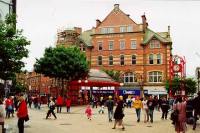
Background Information on Northern Ireland Society[CAIN_Home] [Key_Events] [Key_Issues] [CONFLICT_BACKGROUND] NI SOCIETY: [Agriculture] [Art_&_Literature] [Culture] [Economy] [Education] [Employment] [Geography] [Health_&_Social_Security] [History] [Housing] [Income] [Law_&_Order] [Maps] [Media] [Politics] [Population] [Religion] [Security] [Tourism] [Transportation] Material is added to this site on a regular basis - information on this page may change Introduction
The violence that occurred in Northern Ireland had a direct and obvious impact on certain aspects of life in the region most notably the security response and the conduct of politics. However 'the Troubles', and the underlying divisions in the community, had an impact to varying degrees on most aspects of life in the region. In addition the conflict has been reflected in things such as the arts and literature. The material available at the links below includes, key facts and figures on demographic and socioeconomic aspects of the society in which 'the Troubles' occurred. This information has been gathered from official statistics as well as research reports. Most of the statistical information was compiled in 1996-1997 with the aim of indicating what society was like when the violence was on-going. Only some of the tables have been update; more up-dating may be done in the future. There are also links to articles on the particular topics, and images as in the case of murals. The main headings are listed in alphabetical order. [For current statistical information see: NI Statistics and Research Agency, NISRA] This section will contain examples of the impact the conflict has had on the arts and literature. The most obvious expression of British or Unionist culture in Northern Ireland are the 2,500 parades and marches organised by the Loyal Orders each year. Irish and Nationalist culture finds expression in music, dance, the arts, and Gaelic (the Irish language).
Outline of historical events in Ireland for the period from 1603 to the outbreak of the current conflict. For information on the current conflict see the chronology for the years 1968 to the present and also key events. See also the background article 'Conflict in Northern Ireland: A Background Essay' by John Darby.
See information on Politics, Political Parties and the Electoral System and also the Peace Process.
The level of tourism during the period 1969 to 1994 was adversely affected by the conflict. The paramilitary ceasefires of 1994 encouraged people to visit Northern Ireland and 1995 proved to be a record year.
|
CAIN
contains information and source material on the conflict
and politics in Northern Ireland. CAIN is based within Ulster University. |
|
|
|||
|
Last modified :
|
||
|
| ||
